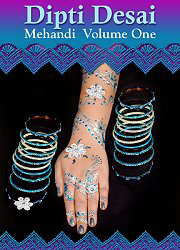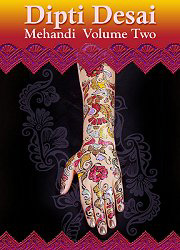by Dipti Desai,c 2004
professional henna artist in Ahmadabad. Gujarat, India
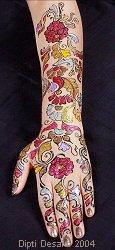
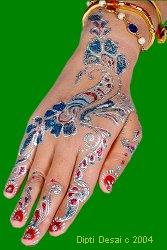
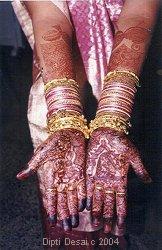
|
Art is a gift of Almighty to mankind, the best creature of creation. Mankind has been given different senses, special gifts, greater than those given to animals. These senses give mankind the means to appreciate the finer things in life, such as Mehandi. Women are gifted, and have been active with their gifts since ancient times and around the world. Indian women are naturally mindful of ‘Karma’, the Sanskrit word for “actions and their affects”. (“The effect of virtuous actions is happiness and the effect of negative actions is suffering.”) Women instinctively manage their homes and family with their gifts. Their attention to their homes, their bodies and their community is reflected in their artistic adornments. With my gift and the encouragement of my friends and family, I have been able to develop my artistic abilities. Their inspiration has helped me achieve my current status as a Mehandi artist. Hindu women are covered from head-to-toe to conceal them from the prying eyes of strangers. Marriage is not simply a festival of joy but it is considered as an extraordinary event in the man and the woman’s life. According to Hindu Vedas, marriage is the union of two hearts and agreement to stay with each other during all trials of life. Particularly for women, it is a drastic change. Her family members show affection by adorning her with very special dresses, jewelry, flowers, hairstyle, etc. Her face, hands and legs are also decorated. India is a large country and each part has its own traditions and ceremonies. In Rajasthan and Punjab states, there is a special " Mehandi" party for the bridegroom People have get together, sing songs, dance, organize jokes, hire musicians, and have a great party for the bridegroom's henna. Although wedding ceremonies have changed considerably in their style and setting in recent years, many customs are still observed with modern ideas and tastes. The wedding ceremony would not be complete without beautiful Mehandi on the bride’s legs and hands. A dark stain signifies a strong love of her husband and her family. In India, towns and areas have different marriage traditions and ceremonies. In Rajasthan and Punjab regions, there is a Mehandi-applying event where the bride and the female family members gather to sing, dance, and have fun together. When the Mehandi is finished, we sing this song in Gujarati: "Mehandi
to vavi malve,
ano rang gayo Gujarat re, Mehandi rang lagyo re..." Mehandi has become a livelihood for many artists, who can charge large amounts of money, depending on the placement on the body (such as palms, shoulders, neck, belly, legs, etc). In some regions, Mehandi is a 7-day event, with new Mehandi each day to match outfit changes. The colour of the Mehandi can also be applied differently to achieve different colors. Professionals charge substantial amounts of money for these applications. "Mehandi"* is prepared from the leaves of Lawsonia Inermis, with the Arabic name "Henna". In Gujurat, henna is commonly known as Mehandi. The processed powder may contain plants other than henna, such as madder, myrobalan, and alkanet, whose roots and skin contain red dyes. The proportions of these additional plants and ingredients in the mix slightly change the color, making it more orange, more red, or more brown. Lemon juice; strong tea, eucalyptus oil are mixed with the powder and kept for six to eight hours to prepare the paste. The paste is put in a cone for further application, Eucalyptus oil changes the color of Mehandi from an orange or red color to a darker red or brown color. Now that we have briefly covered the traditions and uses of Mehandi, we can then move on to the different styles:, and ways of creating them Click on these links to see the styles! Styles Done in Natural Henna Indian Mehandi , Rajwadi Mehandi, and Arabian Mehandi Styles Done in Embellished Natural Henna, Natural henna with with gilding and cosmetic paste Geru Mehandi, Black-Brown Shaded Mehandi, Hiramoti Mehandi Styles Done in Gilding, Zardosi and Cosmetic Pastes Zardosi Mehandi, Embroidery Mehandi, Cocktail Mehandi, Chundana Tattoo Styles Done with Gems. Sequins, Ribbons. Gilding and Zardosi Pastes Soneri Mehandi, Diamond Mehandi, Anokhi Mehandi You can create these effects safely with "off the shelf" theatrical cosmetics and other products? Ben Nye, and Mehron all have waterproof and water resistant lines of safe, FDA approved cosmetics, and sealants that you can use to duplicate Dipti's contemporary Gujerati bridal mehandi! Temptu and other airbrush tattoo companies also have products which will do similar work. More information here! How
do you create Zardosi, Gilding and Cosmetic Pastes yourself?
Go here!  Henna Page Publications will soon publish Dipti Desai's new henna books featuring her designs and full size photographs of her beautiful work in full color! Coming soon! TapDancing Lizard
publishes Dipti Desai's new henna books
|
